2007 SUZUKI FORENZA ECU
[x] Cancel search: ECUPage 16 of 225
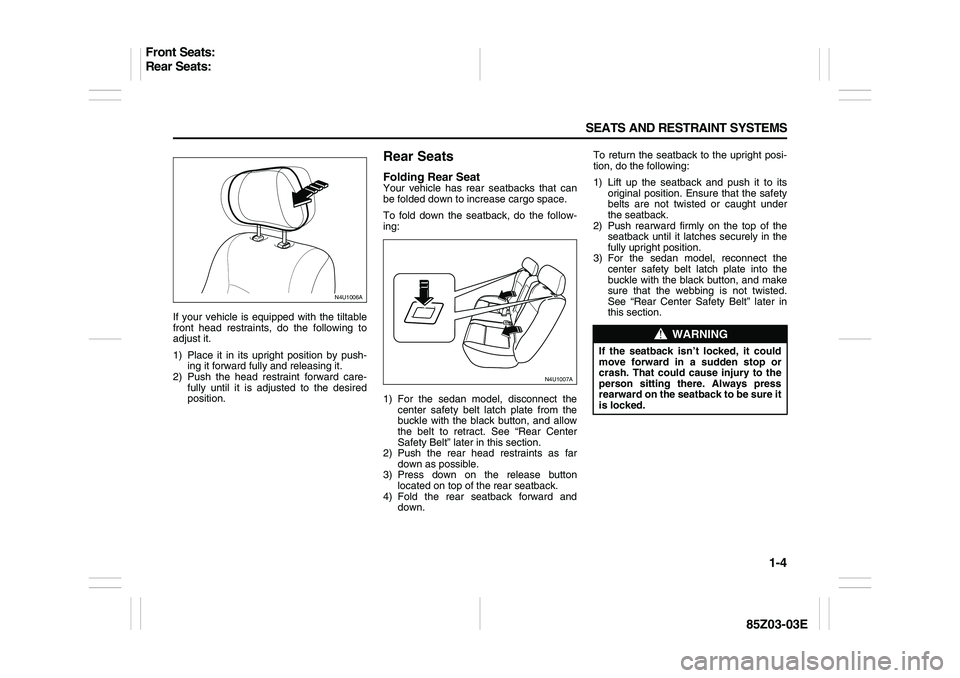
1-4 SEATS AND RESTRAINT SYSTEMS
85Z03-03E
If your vehicle is equipped with the tiltable
front head restraints, do the following to
adjust it.
1) Place it in its upright position by push-
ing it forward fully and releasing it.
2) Push the head restraint forward care-
fully until it is adjusted to the desired
position.
Rear SeatsFolding Rear SeatYour vehicle has rear seatbacks that can
be folded down to increase cargo space.
To fold down the seatback, do the follow-
ing:
1) For the sedan model, disconnect the
center safety belt latch plate from the
buckle with the black button, and allow
the belt to retract. See “Rear Center
Safety Belt” later in this section.
2) Push the rear head restraints as far
down as possible.
3) Press down on the release button
located on top of the rear seatback.
4) Fold the rear seatback forward and
down.To return the seatback to the upright posi-
tion, do the following:
1) Lift up the seatback and push it to its
original position. Ensure that the safety
belts are not twisted or caught under
the seatback.
2) Push rearward firmly on the top of the
seatback until it latches securely in the
fully upright position.
3) For the sedan model, reconnect the
center safety belt latch plate into the
buckle with the black button, and make
sure that the webbing is not twisted.
See “Rear Center Safety Belt” later in
this section.
N4U1006A
N4U1007A
WARNING
If the seatback isn’t locked, it could
move forward in a sudden stop or
crash. That could cause injury to the
person sitting there. Always press
rearward on the seatback to be sure it
is locked.
Front Seats:
Rear Seats:
Page 19 of 225
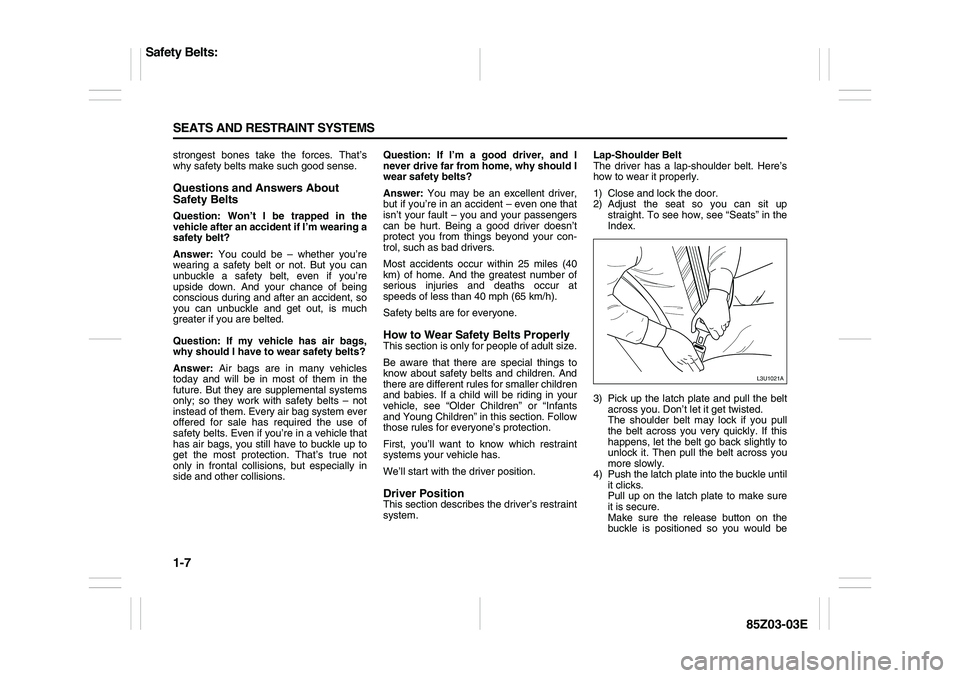
1-7 SEATS AND RESTRAINT SYSTEMS
85Z03-03E
strongest bones take the forces. That’s
why safety belts make such good sense.Questions and Answers About
Safety BeltsQuestion: Won’t I be trapped in the
vehicle after an accident if I’m wearing a
safety belt?
Answer: You could be – whether you’re
wearing a safety belt or not. But you can
unbuckle a safety belt, even if you’re
upside down. And your chance of being
conscious during and after an accident, so
you can unbuckle and get out, is much
greater if you are belted.
Question: If my vehicle has air bags,
why should I have to wear safety belts?
Answer: Air bags are in many vehicles
today and will be in most of them in the
future. But they are supplemental systems
only; so they work with safety belts – not
instead of them. Every air bag system ever
offered for sale has required the use of
safety belts. Even if you’re in a vehicle that
has air bags, you still have to buckle up to
get the most protection. That’s true not
only in frontal collisions, but especially in
side and other collisions.Question: If I’m a good driver, and I
never drive far from home, why should I
wear safety belts?
Answer: You may be an excellent driver,
but if you’re in an accident – even one that
isn’t your fault – you and your passengers
can be hurt. Being a good driver doesn’t
protect you from things beyond your con-
trol, such as bad drivers.
Most accidents occur within 25 miles (40
km) of home. And the greatest number of
serious injuries and deaths occur at
speeds of less than 40 mph (65 km/h).
Safety belts are for everyone.
How to Wear Safety Belts ProperlyThis section is only for people of adult size.
Be aware that there are special things to
know about safety belts and children. And
there are different rules for smaller children
and babies. If a child will be riding in your
vehicle, see “Older Children” or “Infants
and Young Children” in this section. Follow
those rules for everyone’s protection.
First, you’ll want to know which restraint
systems your vehicle has.
We’ll start with the driver position.Driver PositionThis section describes the driver’s restraint
system.Lap-Shoulder Belt
The driver has a lap-shoulder belt. Here’s
how to wear it properly.
1) Close and lock the door.
2) Adjust the seat so you can sit up
straight. To see how, see “Seats” in the
Index.
3) Pick up the latch plate and pull the belt
across you. Don’t let it get twisted.
The shoulder belt may lock if you pull
the belt across you very quickly. If this
happens, let the belt go back slightly to
unlock it. Then pull the belt across you
more slowly.
4) Push the latch plate into the buckle until
it clicks.
Pull up on the latch plate to make sure
it is secure.
Make sure the release button on the
buckle is positioned so you would be
L3U1021A
Safety Belts:
Page 24 of 225
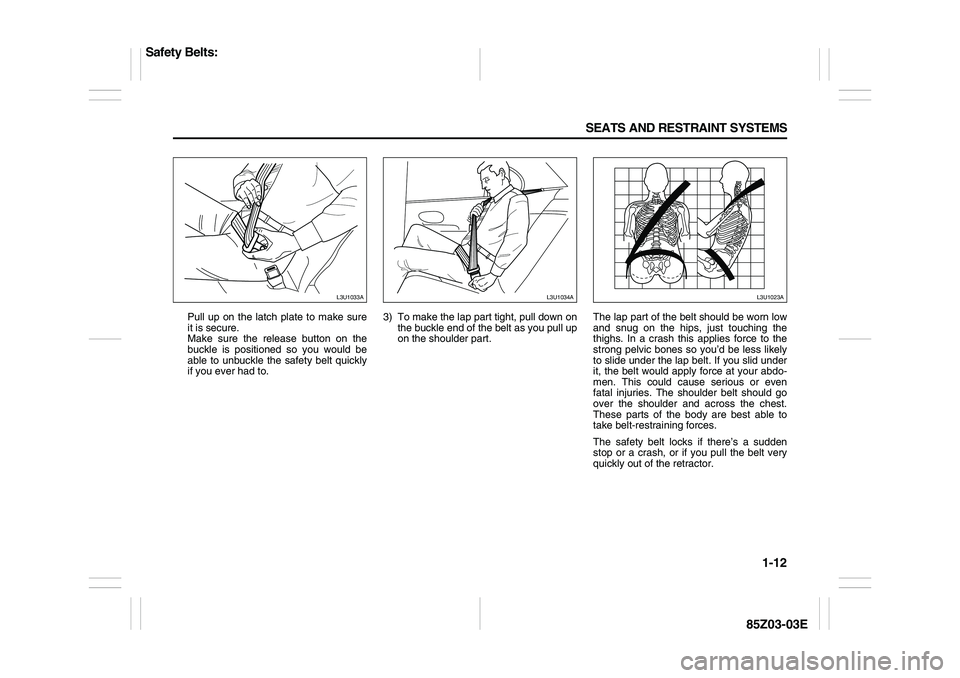
1-12 SEATS AND RESTRAINT SYSTEMS
85Z03-03E
Pull up on the latch plate to make sure
it is secure.
Make sure the release button on the
buckle is positioned so you would be
able to unbuckle the safety belt quickly
if you ever had to.3) To make the lap part tight, pull down on
the buckle end of the belt as you pull up
on the shoulder part.The lap part of the belt should be worn low
and snug on the hips, just touching the
thighs. In a crash this applies force to the
strong pelvic bones so you’d be less likely
to slide under the lap belt. If you slid under
it, the belt would apply force at your abdo-
men. This could cause serious or even
fatal injuries. The shoulder belt should go
over the shoulder and across the chest.
These parts of the body are best able to
take belt-restraining forces.
The safety belt locks if there’s a sudden
stop or a crash, or if you pull the belt very
quickly out of the retractor.
L3U1033A
L3U1034A
L3U1023A
Safety Belts:
Page 25 of 225
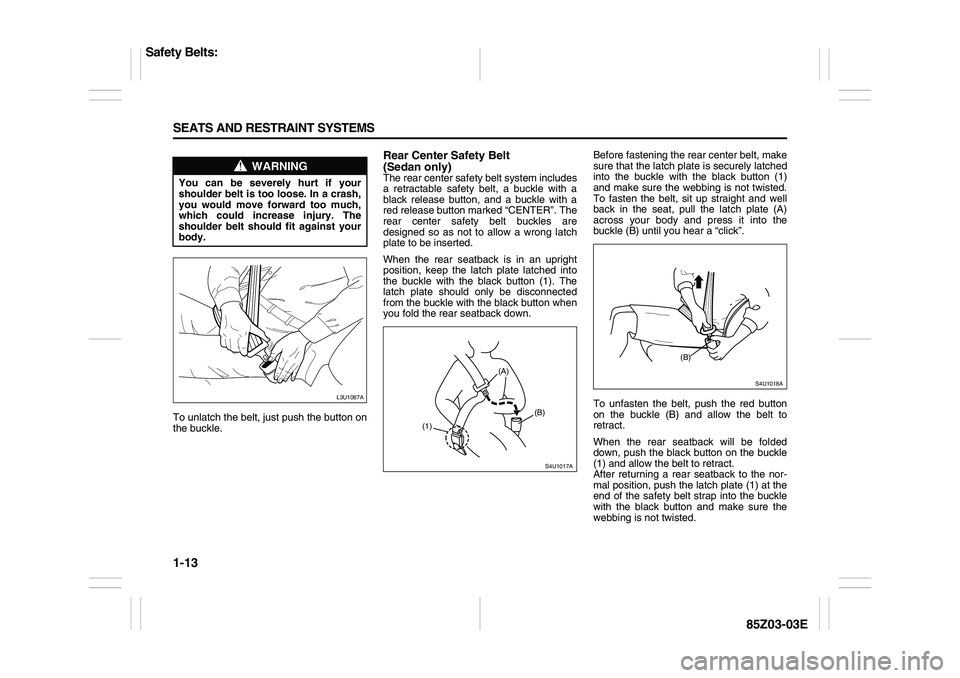
1-13 SEATS AND RESTRAINT SYSTEMS
85Z03-03E
To unlatch the belt, just push the button on
the buckle.
Rear Center Safety Belt
(Sedan only)The rear center safety belt system includes
a retractable safety belt, a buckle with a
black release button, and a buckle with a
red release button marked “CENTER”. The
rear center safety belt buckles are
designed so as not to allow a wrong latch
plate to be inserted.
When the rear seatback is in an upright
position, keep the latch plate latched into
the buckle with the black button (1). The
latch plate should only be disconnected
from the buckle with the black button when
you fold the rear seatback down.Before fastening the rear center belt, make
sure that the latch plate is securely latched
into the buckle with the black button (1)
and make sure the webbing is not twisted.
To fasten the belt, sit up straight and well
back in the seat, pull the latch plate (A)
across your body and press it into the
buckle (B) until you hear a “click”.
To unfasten the belt, push the red button
on the buckle (B) and allow the belt to
retract.
When the rear seatback will be folded
down, push the black button on the buckle
(1) and allow the belt to retract.
After returning a rear seatback to the nor-
mal position, push the latch plate (1) at the
end of the safety belt strap into the buckle
with the black button and make sure the
webbing is not twisted.
WARNING
You can be severely hurt if your
shoulder belt is too loose. In a crash,
you would move forward too much,
which could increase injury. The
shoulder belt should fit against your
body.
L3U1067A
S4U1017A
(1)(A)
(B)
S4U1018A
(B)
Safety Belts:
Page 27 of 225

1-15 SEATS AND RESTRAINT SYSTEMS
85Z03-03E
impacts, side impacts, rollovers or minor
frontal collisions. The pretensioners can be
activated only once. If the pretensioners
are activated, have the pretensioner sys-
tem serviced by an authorized SUZUKI
dealer as soon as possible.
If the air bag readiness light on the instru-
ment cluster does not blink or come on
briefly when the ignition switch is turned to
the “ON” position, stays on for more than
10 seconds, or comes on while driving, the
pretensioner system or the air bag system
may not work properly. Have both systems
inspected by an authorized SUZUKI dealer
as soon as possible.
Service on or around the pretensioner sys-
tem components or wiring must be per-
formed only by an authorized SUZUKI
dealer who is specially trained. Improper
service could result in unintended activa-
tion of pretensioners or could render the
pretensioners inoperative. Either of these
two conditions may result in personal
injury.
To prevent damage or unintended activa-
tion of the pretensioners, be sure the bat-
tery is disconnected and the ignition switch
has been in the “LOCK” position for at least
60 seconds before performing any electri-
cal service work on your SUZUKI. Do not
touch pretensioner system components or
wiring. The wires are wrapped with yellow
tape or yellow tubing, and the couplers are
yellow. When scrapping your SUZUKI, askyour SUZUKI dealer, body repair shop or
scrap yard for assistance.
Safety Belt Extender
65D613
(1) Center of body
(2) Less than 152 mm (6 inches)
(3) Open end of extender buckle
If a safety belt cannot be fastened securely
because it is not long enough, see your
authorized SUZUKI dealer for a safety belt
extender. Safety belt extenders are avail-
able for each seating position except for
the rear center position. After inspecting
the relationship between the safety belt
length, the occupant’s body size, and the
seat adjustment (the driver’s seat should
always be adjusted as far back as possible
while still maintaining control of the vehicle,
and other adjustable seats should be
adjusted as far back as possible), yourSUZUKI dealer can select the appropriate
safety belt extender.
A safety belt extender should only be
used for the person, vehicle and seating
location it was provided for.
When using the extender, ensure that
both ends are latched securely. Do not
use the extender if the open end of the
extender’s buckle is within 152 mm (6
inches) of the center of the occupant’s
body (See diagram). Use of the extender
when the buckle is too close to the cen-
ter of the body could increase the risk of
abdominal injury in the event of an acci-
dent, and could cause the shoulder belt
to be positioned incorrectly.
Make sure to use the correct buckle cor-
responding to your seating position.
Safety belt extenders are not intended
for use by pregnant women, and should
only be used upon approval by their
medical advisors.
Remove and stow the extender when it
is not being used.
Safety Belts:
Page 28 of 225

1-16 SEATS AND RESTRAINT SYSTEMS
85Z03-03E
Child RestraintsOlder ChildrenOlder children who have outgrown booster
seats should wear the vehicle’s safety
belts.
Question: What is the proper way to
wear safety belts?
Answer: If possible, an older child should
wear a lap-shoulder belt and get the addi-
tional restraint a shoulder belt can provide.
The shoulder belt should not cross the face
or neck. The lap belt should fit snugly
below the hips, just touching the top of the
thighs. It should never be worn over the
abdomen, which could cause severe or
even fatal internal injuries in a crash.Accident statistics show that children are
safer if they are restrained in the rear seat.
In a crash, children who are not buckled up
can strike other people who are buckled
up, or can be thrown out of the vehicle.
Older children need to use safety belts
properly.
WARNING
Failure to follow these instructions
may increase the risk of injury in a
crash.
Only use an extender for the per-
son, vehicle and seating position it
was provided for.
A front safety belt extender must
only be used in a front seating
position, and a rear safety belt
extender must only be used in a
rear seating position.
Safety belt extenders are not
intended for use by pregnant
women, and should only be used
upon approval by their medical
advisors.
The extender has been designed
for adults. Never use it for securing
child seats.
Do not use a safety belt extender if
the open end of the extender’s
buckle is within 152 mm (6 inches)
of the center of the occupant’s
body (See diagram).
Remove and stow the extender
when it is not being used.
L3U1036A
WARNING
Never do this.
Here two children are wearing the
same belt. The belt can’t properly
spread the impact forces. In a crash,
the two children can be crushed
together and severely injured. A belt
must be used by only one person at a
time.
L3U1037A
Safety Belts:
Child Restraints:
Page 29 of 225
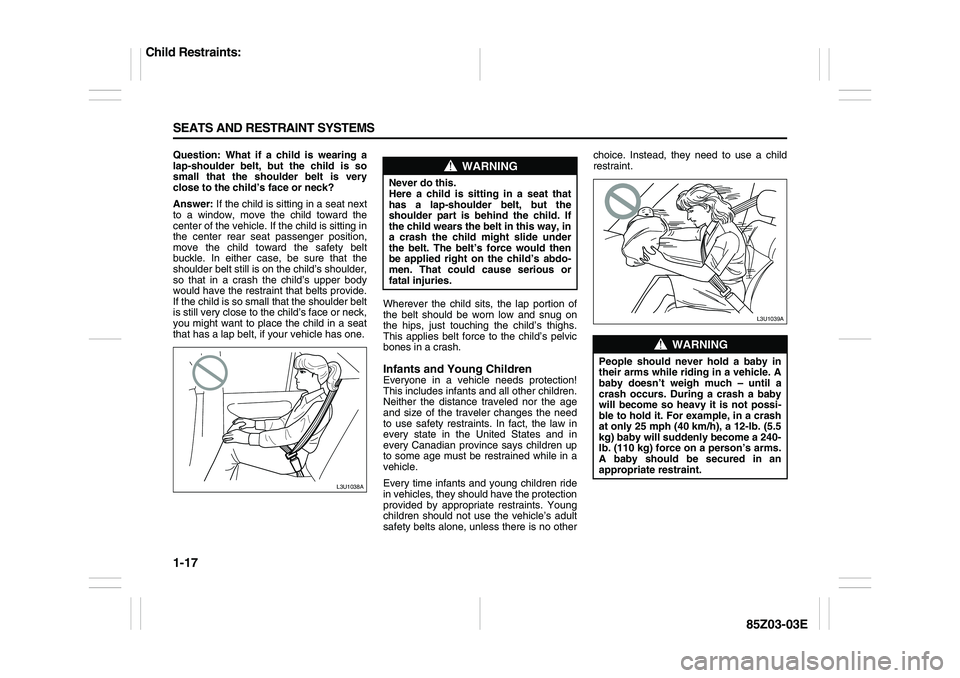
1-17 SEATS AND RESTRAINT SYSTEMS
85Z03-03E
Question: What if a child is wearing a
lap-shoulder belt, but the child is so
small that the shoulder belt is very
close to the child’s face or neck?
Answer: If the child is sitting in a seat next
to a window, move the child toward the
center of the vehicle. If the child is sitting in
the center rear seat passenger position,
move the child toward the safety belt
buckle. In either case, be sure that the
shoulder belt still is on the child’s shoulder,
so that in a crash the child’s upper body
would have the restraint that belts provide.
If the child is so small that the shoulder belt
is still very close to the child’s face or neck,
you might want to place the child in a seat
that has a lap belt, if your vehicle has one.Wherever the child sits, the lap portion of
the belt should be worn low and snug on
the hips, just touching the child’s thighs.
This applies belt force to the child’s pelvic
bones in a crash.
Infants and Young ChildrenEveryone in a vehicle needs protection!
This includes infants and all other children.
Neither the distance traveled nor the age
and size of the traveler changes the need
to use safety restraints. In fact, the law in
every state in the United States and in
every Canadian province says children up
to some age must be restrained while in a
vehicle.
Every time infants and young children ride
in vehicles, they should have the protection
provided by appropriate restraints. Young
children should not use the vehicle’s adult
safety belts alone, unless there is no otherchoice. Instead, they need to use a child
restraint.
L3U1038A
WARNING
Never do this.
Here a child is sitting in a seat that
has a lap-shoulder belt, but the
shoulder part is behind the child. If
the child wears the belt in this way, in
a crash the child might slide under
the belt. The belt’s force would then
be applied right on the child’s abdo-
men. That could cause serious or
fatal injuries.
WARNING
People should never hold a baby in
their arms while riding in a vehicle. A
baby doesn’t weigh much – until a
crash occurs. During a crash a baby
will become so heavy it is not possi-
ble to hold it. For example, in a crash
at only 25 mph (40 km/h), a 12-lb. (5.5
kg) baby will suddenly become a 240-
lb. (110 kg) force on a person’s arms.
A baby should be secured in an
appropriate restraint.
L3U1039A
Child Restraints:
Page 30 of 225
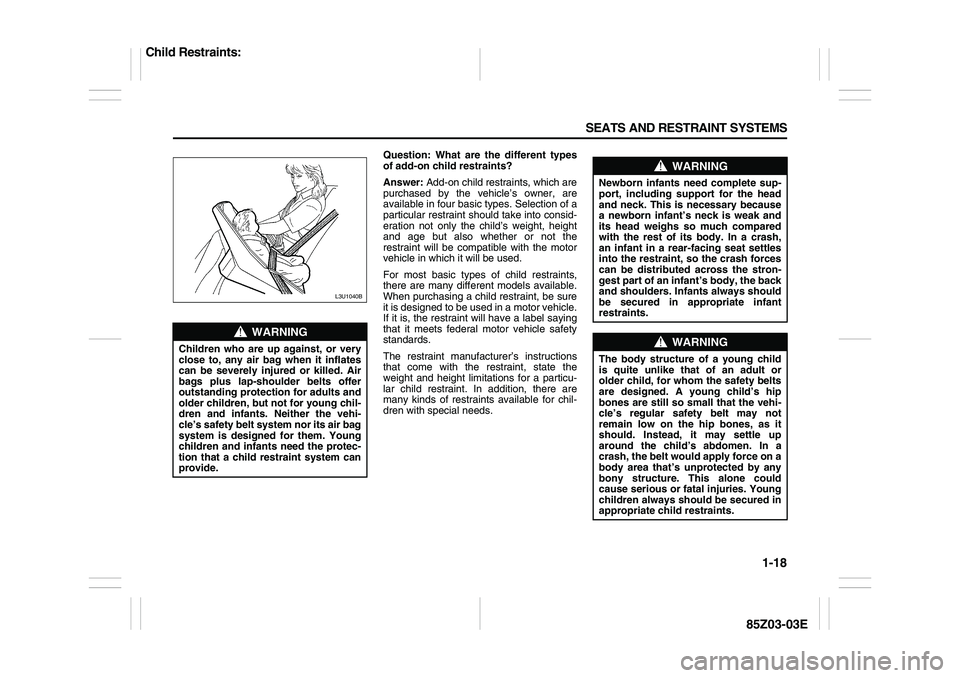
1-18 SEATS AND RESTRAINT SYSTEMS
85Z03-03E
Question: What are the different types
of add-on child restraints?
Answer: Add-on child restraints, which are
purchased by the vehicle’s owner, are
available in four basic types. Selection of a
particular restraint should take into consid-
eration not only the child’s weight, height
and age but also whether or not the
restraint will be compatible with the motor
vehicle in which it will be used.
For most basic types of child restraints,
there are many different models available.
When purchasing a child restraint, be sure
it is designed to be used in a motor vehicle.
If it is, the restraint will have a label saying
that it meets federal motor vehicle safety
standards.
The restraint manufacturer’s instructions
that come with the restraint, state the
weight and height limitations for a particu-
lar child restraint. In addition, there are
many kinds of restraints available for chil-
dren with special needs.
WARNING
Children who are up against, or very
close to, any air bag when it inflates
can be severely injured or killed. Air
bags plus lap-shoulder belts offer
outstanding protection for adults and
older children, but not for young chil-
dren and infants. Neither the vehi-
cle’s safety belt system nor its air bag
system is designed for them. Young
children and infants need the protec-
tion that a child restraint system can
provide.
L3U1040B
WARNING
Newborn infants need complete sup-
port, including support for the head
and neck. This is necessary because
a newborn infant’s neck is weak and
its head weighs so much compared
with the rest of its body. In a crash,
an infant in a rear-facing seat settles
into the restraint, so the crash forces
can be distributed across the stron-
gest part of an infant’s body, the back
and shoulders. Infants always should
be secured in appropriate infant
restraints.
WARNING
The body structure of a young child
is quite unlike that of an adult or
older child, for whom the safety belts
are designed. A young child’s hip
bones are still so small that the vehi-
cle’s regular safety belt may not
remain low on the hip bones, as it
should. Instead, it may settle up
around the child’s abdomen. In a
crash, the belt would apply force on a
body area that’s unprotected by any
bony structure. This alone could
cause serious or fatal injuries. Young
children always should be secured in
appropriate child restraints.
Child Restraints: